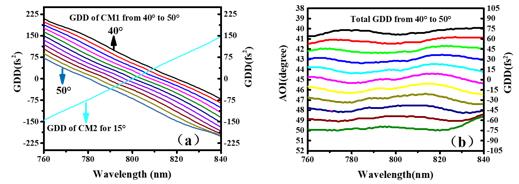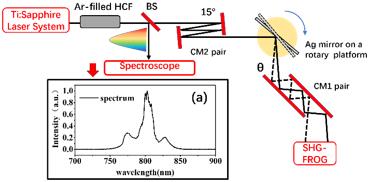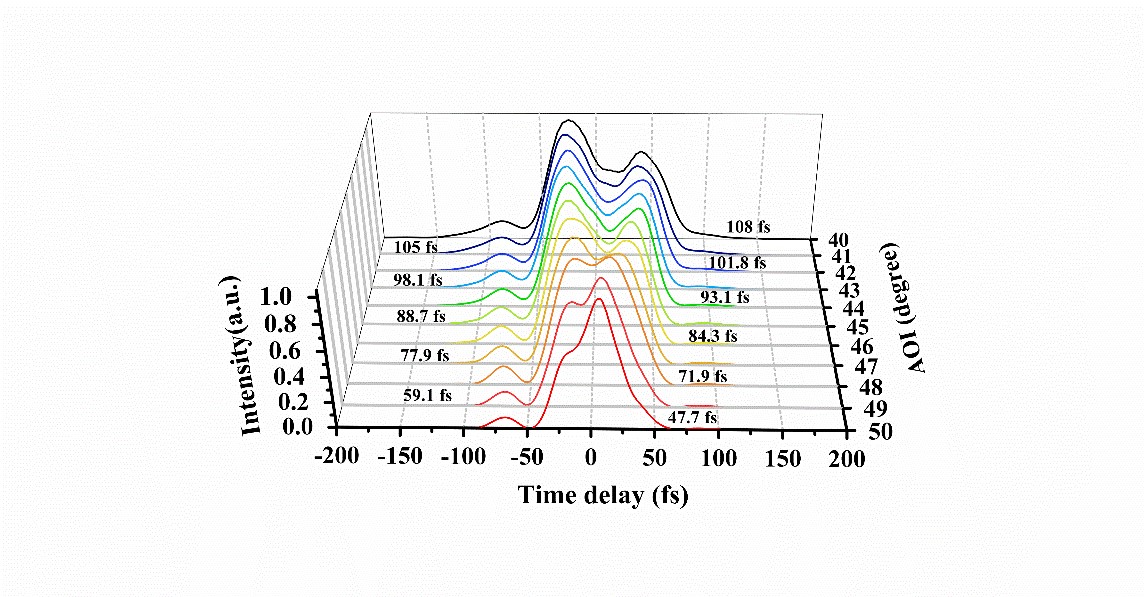When multilayers are irradiated by laser pulses, the change of incident angle will lead to the optical path change of the incident pulses in all layers. With the advantages of compactness, reproducibility, and insensitivity to misalignment, chirped mirrors (CMs) have been widely used in ultrafast laser system to balance the frequency-dependent dispersion in the laser cavity. However, traditional CMs fail to provide continuous dispersion.
Recently, researchers from Shanghai institute of Optics and Fine Mechanics, Chinese Academy of Sciences, reported the feasibility of continuously tunable dispersion control with CMs. Continuously tunable group delay dispersion (GDD) was achieved by altering the angles of incidence on the mirrors. Moreover, continuous duration tunable laser pulses were demonstrated by applying GDD-tunable CMs in an ultrafast laser system. The results were published in Optics Letters.
The study was based on multilayer dielectric film on femtosecond laser transmission. They found that, when the incident Angle changes were caused by the change of the optical pulse through the membrane layer thickness, by controlling the pulse reflection and transmission in each layer of the phase change, they could implement two mirrors (CM1 and CM2) with opposite group delay dispersion (GDD) curve slope, thus a GDD-tunable CM was achieved.
In this study, the total dispersion compensation was continuously adjustable from 300fs2 to -300fs2 and the pulse width was continuously tuned from 108 fs to 47.7 fs by adjusting the incident Angle from 40° to 50° in a dispersion mirror and reflecting the pulse on a single mirror for 4 times. While traditional dispersive films cannot be tuned to compensate the dispersion, this dispersion-tunable chirped mirror can provide flexible dispersion compensation in the ultra-fast laser system, which guarantees the pulse output with high quality.

FIG. 1: (a) Theoretical GDD (P polarization) of the designed CM1 and CM2.
(b) The total GDD is tunable from positive to negative. (Image by SIOM)
FIG. 2: Schematic layout of the experimental setup. (Image by SIOM)
FIG. 3: Pulse traces are demonstrated. (Image by SIOM)
In addition, researchers reported on a novel starting design structure of highly-dispersive mirror (HDM), which combined quarter wavelength structure and multi-cavities, introducing more wavelength-dependent storage times of incident radiation and group delay (GD). Based on such structure, a HDM with new advanced group delay dispersion (GDD) of -20,000 fs2 in the wavelength range of 1,035–1,045 nm was designed, fabricated and characterized.
The HDM has been applied in a fiber-chirped system, providing a considerable compensation of GDD reaching -200,000 fs2 with only 10 reflections between two mirrors, and also laser pulse compression from 2.8 ps to 213 fs was realized. The findings were published online in IEEE Photonics Technology Letters.

FIG. 4: (a) Physical thickness of each layer of the optimized HDM.
(b) Autocorrelation of 213-fs output pulse duration.
(c) 2.8-ps input pulse duration. (Image by SIOM)
This work was supported by the NSAF jointly set up by the National Natural Science Foundation of China and the Chinese Academy of Engineering Physics, the Youth Innovation Promotion Association of CAS, the Innovation Foundation of CAS, and the Strategic Priority Research Program of CAS.
Article website:
https://www.osapublishing.org/ol/abstract.cfm?uri=ol-44-24-6053
https://ieeexplore.ieee.org/document/8932582
Contact:
Mr. CAO Yong
General Administrative Office
Shanghai Institute of Optics and Fine Mechanics, CAS
Email: caoyong@siom.ac.cn